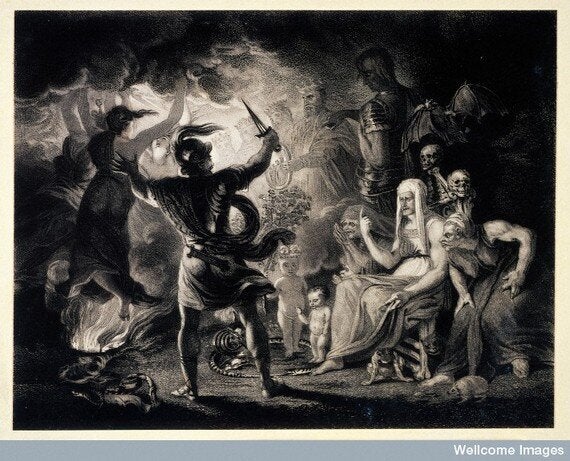Macbeth is up there with Shakespeare's complex alpha males: ambitious, ruthless, dangerous. So it may seem surprising that director Justin Kurzel puts women and children at the centre of the action in his adaptation of the tragedy. But this decision pays off, giving the story an intriguing feminist dimension which speaks directly to us today.
As I was finishing this post, I heard the relatives of dead peace protesters in Turkey on the news, weeping for their loved ones. One of the victims was an eighty four year old woman who had come to bear witness as a Mother of Peace. In 2015 violence begets violence and blood will have blood. We need this play and its exploration of the male lust for power as much now as we ever did.

Here are 10 reasons why this version of Macbeth is a feminist film:
1.The first image we see is a dead child: the camera lingers on the Macbeths' toddler son being prepared for ritual cremation. Both parents grieve, but Marion Cotillard's Lady Macbeth is deadly pale, almost zombie-like.
2.Kurzel has presented a more fully-realised Lady Macbeth than we have seen before, giving her additional screen time. Her emotional journey is brought into focus, and she is haunted by the ghost of her lost son. Desperation to fill a void fuels her ambition for her husband.
3.As a bereaved father Michael Fassbender's Macbeth is initially sympathetic - we don't immediately see him as simply a man of violence.
4.Macbeth can transform his sorrow into action, hurling himself into the frantic business of murder and cover-up. But Lady Macbeth has no such outlet. Once she has persuaded Macbeth to murder Duncan, she freezes into a trance. Having betrayed her gender by pushing for the murder of the king, death is the only reality she knows.
5.Parents and family life are a recurring motif. The faces of women and their children stare out of the crowd scenes, powerless to help themselves. Lady Macduff rages passionately against the Stalinesque Macbeth when he kills her and her small children, while they are silent, stilled by terror.
6.The witches first appear on the battlefield, as if summoned by violence and death. In Roman Polanski's 1971 adaptation, they are weird grotesques, personifying evil. But where Polanski's deployment of nudity and female sexuality channelled the casual misogyny of the 1970s, Kurzel's witches are elemental beings, amoral rather than evil, conjured to to see Macbeth's story through.
7.There are four witches, not three. One of them nurses a baby and the fourth is a little girl. This break with the mystical power of three suggests that they aren't just 'magical'; they are part of the natural order of things, an order torn apart by male aggression.
8.Though this is a very 21st century take on the tragedy, it's also true to Shakespeare's vision. In William Shakespeare (1986) Terry Eagleton calls the witches the true heroines of the play.
9.The film presents women as a counter weight to men, a force for peace and community and against bloodshed. Such ideas play to Marilyn French's theories about male potency. In Beyond Power: On Women, Men and Morals (1986) she argues that men's lust for political and public dominance is part of a futile quest to compensate for their inability to bear children.
10.Violence is shown to be futile. In the end, Macbeth's corpse is left hunched and kneeling on the blood red screen. Fleance, the young son of murdered Banquo, steals his sword and runs out of frame and into the future. No amount of ambition can benefit a childless man with nothing to leave behind, and Macbeth dies knowing this.
Picture Credit: 0032439 Credit: Wellcome Library, London WITCHCRAFT: Macbeth seeing three witches.
Engraving after Reynolds c. 1786. Catalogue no. 47617i.Published: [s.n.][S.l.] :
Size: image 17.7 x 23 cm. Collection: Iconographic Collections Library reference no.: Iconographic Collection 47617i Full Bibliographic Record Link to Wellcome Library Catalogue